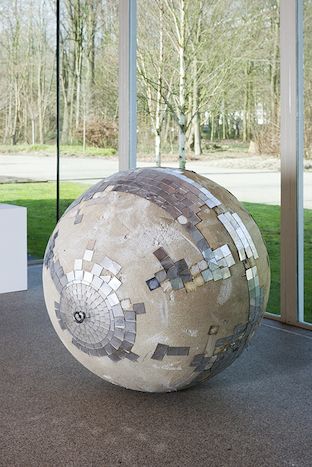IN CONVERSATION WITH SEMÂ BEKIROVIĆ EN GIJSJE HEEMSKERK
Artist Semâ Bekirović has often collaborated with natural processes and entities. Her most recent exhibition project ‘Reading By Osmosis’ at Het Glazen Huis (Amsterdam), Bekirović takes on the role of curator, instead of producer, of the art works. She uses her human capacities to offer a platform to non-human artists, thereby showing us that artists don’t necessarily have to be human. In this exhibition the curator attempts to kindle a discussion regarding authorship and the subjectivity of value systems.
An artistic inquiry into natural processes
Gijsje Heemskerk (GH): How would you describe your own role in this project?
Semâ Bekirović (SB): I see myself as curator of the show. Just like any other curator, I developed a concept, and then went looking for artworks that complemented the concept in an interesting way. The only difference is that these artworks are made by non-human artists, like the wind, mussels, and fungi. Taking into account my background as a visual artist, one could think that I am appropriating the objects in the exhibition, like some kind of Marcel Duchamp-style ready-mades. This is not the case. Within the context of the exhibition my position is opposite to Duchamp’s: he appropriated found objects by signing them with his name. The objects I exhibit were made by natural processes. Instead of claiming authorship, I acknowledge the process in question as the work’s maker. All these works originated in the human domain and were appropriated by natural processes. You could call it an artistic research into the ways natural processes interpret humans. Some examples of such processes are: a football covered in moss, and a fence, collapsed under the weight of the ivy that grew over it. Some other participating artists are fire, the river Thames, and crows.

Different approaches to value
GH: Many of the artworks that you are showing could be perceived as garbage by some. How do you decide which of the objects you encounter should be part of the exhibition?
SB: It was a fairly random process. But I would be lying if I told you I didn’t make any aesthetic deliberations. I’m especially fascinated by objects that resemble contemporary art, because there occurs a kind of mirror-effect. I do not harbor romantic notions regarding nature as something separate from me as a person. I am part of nature. The exhibition deals with different approaches to “value”. There are lots of different value systems. What’s valuable to me, doesn’t necessarily hold value for another. This also works on a larger scale: what’s valuable to humans, isn’t necessarily so for moss, or a cat.

The exhibition as a mirror
GH: How do you relate to the non-human artists within this project?
SB: I try to respect their choices and show the works “as found” as much as I can. But I do retain my curatorial license to determine the context. I collaborated with designer Jan-Pieter Karper on the design of the show, which ended up looking traditionally ‘museum-like’. We use pedestals; we didn’t buy these, but borrowed them from Museum Goed, a company renting out pedestals which were used by, amongst others, the Stedelijk Museum in Amsterdam. This is an attempt to present works by non-human artists on an equal footing with works shown in a museum.
I am also exhibiting a work made by fire. I exhibited this work earlier, under my own name and in a different context. The work got sold at the time. By showing it within the context of this show, I effectually disown the piece by acknowledging that is wasn’t me who made the work, but fire. This exhibition is one big mindfuck, I mean, what are these works exactly? How are we supposed to relate to them? In a way, the show questions me as an artist, and even pokes fun at art as a whole. Seen from one perspective, it’s all junk. Seen from another, it has value. Moss, for instance, has a definite preference for growing at certain spots. One could say that this specific growing medium has more value to moss than any other material, and from this preference a specific aesthetics result.

Jan Pieter and I are also working on a book. Philosopher Michael Marder, known from his books on plant ethics, is writing a text for this publication. This text will be about art as planetary metabolism and will focus on both human art history and nature’s artistic expressions, and how these can help us re-frame our thoughts on the world we live in, especially in light of the large-scale ecological changes occurring at the moment. Marder states that since Freud, art has been seen as happening mostly in the realm of the unconscious. The unconscious, in Marder’s view, is essentially “plant-like”. In this publication, he will shed light on the agency and value-systems of non-human entities from a post-humanist viewpoint.
Gijsje Heemskerk is a visual artist and philosopher. She studied Philosophy and Arts and Culture at the University of Amsterdam. Throughout her studies she mainly focused on posthumanism and art and animals. Her work consists, among other things, of texts, performance, sculpture, drawings, and paintings, and references folklore, outsider art, and children’s drawings.
Semâ Bekirović is a visual artist and curator. She studied at the Rietveld Academie and the Rijksacademie in Amsterdam. Marcus Bruystens on her work: Bekirović’s work is best described as playful conceptualism. Like reality, it’s a universe of temporary constellations wherein objects, people, animals and/or chemical reactions trigger one another into acting out their parts in a play directed by coincidence. Bekirović creates a field of tension between the parameters she defines and her subject’s personal agenda. She eschews a hands-on, interfering approach, allowing her subject to co-author the work.
The exhibition “Reading By Osmosis” ran from February 16 until April 14 2019 at Het Glazen Huis/ Zone2Source in Amstelpark, Amsterdam.

